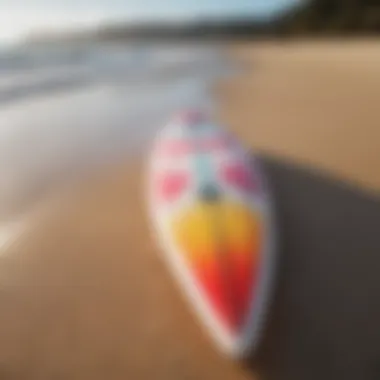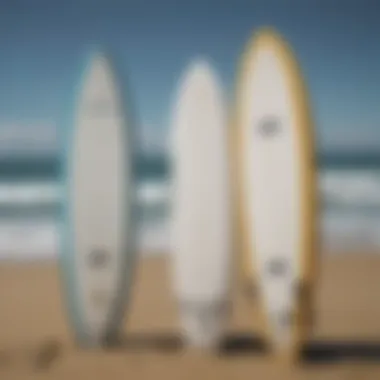Your Ultimate Beginner's Guide to Soft Top Surfboards


Intro
Surfing is not just a sport; it’s a lifestyle that echoes with the rhythm of the waves and the call of the ocean. For newcomers eager to ride these waves, selecting the right surfboard can seem like navigating a maze. Among the various types available, soft top surfboards have emerged as a popular option for beginners. With their forgiving nature and design tailored to ease the learning curve, they serve as the perfect gateway to the exhilarating world of surfing.
In this guide, we will explore the intricacies of soft top surfboards, delving into their unique features, benefits, and the vital considerations that new surfers need to keep in mind. By the end of our exploration, you'll not only gain insights into selecting the right board but also learn tips for maintenance and a comparison with hard top surfboards. For those determined to make a splash in the surf scene, this guide sets you on the right path.
Surf Gear and Equipment
Owning the right gear is essential for any surfer, especially for beginners. Without it, the surfing experience can become more than just challenging. The wrong gear can lead to injuries or a frustrating time in the water. Let’s take a closer look at some important aspects of surf gear that will aid you in your surfing journey.
Latest Surfboard Technologies
In recent years, advancements in surfboard technology have revolutionized how boards are constructed. Soft top surfboards typically come equipped with various features designed to enhance performance and safety for beginners. Here are some key technological innovations:
- EVA Foam Top: This soft surface provides cushioning and reduces the chances of injury during falls.
- Epoxy Construction: Lightweight and more buoyant than traditional materials, making it easier to paddle and catch waves.
- Wider Tail and Nose: These designs foster stability, giving novices better balance and control while riding.
By keeping up with the latest trends and offerings in surfboard technology, you can pick a board that matches not only your skill level but also your surfing style.
Essential Accessories for Surfers
Besides the board itself, there are some crucial accessories that new surfers should consider:
- Leash: This attaches your board to your ankle, preventing it from floating away.
- ** wetsuit**: A good wetsuit keeps you warm and protected from the sun, especially in colder waters.
- Surf Wax: Helps increase grip on your board to prevent slipping.
- Board Bag: Protects your surfboard when traveling or storing it at home.
Investing in these essential accessories can dramatically enhance your surfing adventures while ensuring your equipment lasts longer too.
Your soft top surfboard is an extension of yourself; treat it with care, and it will reward you with many unforgettable sessions on the water.
As you dive deeper into the sport, understanding the equipment choices becomes paramount for growth and improvement. This gear lays the foundation for your surfing journey, guiding you towards mastering the waves.
Techniques and Skills
While having the right equipment is crucial, learning the necessary techniques can make or break your surfing experience. Here, we will touch upon some fundamental skills that every beginner should acquire to enhance their time in the water.
Wave Riding Strategies
Riding waves is at the heart of surfing, but it’s an art that requires practice and finesse. Here are some tips for honing your wave riding skills:
- Positioning: Sit on your board and wait for the right wave. Don’t be too eager; patience pays off.
- Paddling: Use long strokes to paddle towards incoming waves and maintain momentum.
- Pop Up: When you feel the wave lift the board, quickly go from lying down to standing. Keep your feet shoulder-width apart for stability.
Safety and Surf Etiquette
Surrounding yourself with fellow surfers can be nerve-wracking, but being aware of the rules can help everyone enjoy the ocean together. Here are some key points:
- Respect the Lineup: Let’s be honest, no one likes a wave hog. Wait your turn.
- Know Your Limits: Don’t push yourself into bigger waves until you’re ready.
- Stay Aware: Keep an eye on your surroundings, and always be alert to other surfers and swimmers around you.
Learning these skills not only protects you but also contributes to a better surfing culture at the beach.
As you embark on your surfing journey, remember that both the right gear and sound techniques will cement your confidence in the water. With practice, patience, and dedication, you will soon find yourself riding the waves with ease and relish.
Preamble to Soft Top Surfboards
In the vast world of surfing, the type of surfboard one chooses can make a world of difference, especially for beginners navigating those initial waves. Soft top surfboards have gained significant traction in recent years, primarily due to their user-friendly nature and safety features. This article aims to demystify soft top surfboards, discussing their design, benefits, and selection criteria for those just stepping into the ocean's depths.
Understanding Surfboard Types
Before diving deep into the soft tops, it's crucial to understand the differences among various surfboard types. Surfboards can be broadly classified into three categories: soft top, hard top, and hybrid boards.
- Soft Top Boards: They feature a foam covering on top, providing a cushioned surface that enhances safety, making them suitable for beginners. This design helps surfers maintain balance as they learn the ropes without the fear of injury from hard materials.
- Hard Top Boards: Generally made from resin or fiberglass, hard tops offer speed and performance but can be unforgiving in the event of a wipeout. Although they are preferred by advanced surfers, the rigid structure can pose risks for novices.
- Hybrid Boards: These combine elements from both soft and hard tops, aiming to provide a balance between safety and performance. However, hybrids can be less forgiving than fully soft boards, especially for those still refining their skills.
Why Soft Tops for Beginners?
Choosing a soft top surfboard as a beginner is not just a matter of preference; it's a decision rooted in practicality and safety. Here are a few compelling reasons:
- Safety First: The soft, cushioned surface reduces the likelihood of injury during spills. It’s a comforting thought for anyone just learning to ride the waves.
- Stability Matters: Soft tops generally offer more stability due to their broader design. This feature helps new surfers stay upright longer, fostering confidence that’s crucial in the early stages of learning.
- Affordability: Compared to their hard-top counterparts, soft tops are usually more budget-friendly, making them accessible for those not yet ready to invest heavily in equipment.
"The journey from being a novice to a seasoned surfer starts with the right board; soft tops serve as both a safety net and a launching pad."
- Easy Handling: Lightweight and manageable, soft top boards allow beginners to navigate their way through the tricky learning curve known as surfing.


The combination of these characteristics makes soft top surfboards an ideal choice for beginners. Understanding the nature of these boards is crucial for anyone ready to embrace the exhilarating, yet challenging world of surfing.
Key Features of Soft Top Surfboards
When it comes to selecting a surfboard, especially for beginners, understanding key features of soft top surfboards can make a world of difference. Soft tops have become a mainstay in the surfing community, primarily due to their beginner-friendly characteristics, which more seasoned surfers also appreciate. This section will delve into the various elements that define soft top surfboards, including material construction, shape and design, as well as safety aspects that should be considered.
Material Construction
Soft top surfboards are primarily made of a foam material, often polyethylene for the deck and expanded polystyrene (EPS) for the core. This construction is pivotal not just for buoyancy but also for overall user experience.
- Foam Deck: The soft top construction allows for a cushioned landing, reducing the jarring effect if a surfer falls off. This is specifically beneficial for beginners still mastering their balance.
- Durability: These boards are quite forgiving. They can endure bumps and hits, making them perfect for thrashing around in the surf, especially when shared among friends or during lessons. A dinged up soft top can often withstand a lot more than a tested hard top.
- Lightweight: Due to their foam nature, soft tops are generally lighter, making them easier to transport and handle for novice surfers who are still getting the hang of it.
In summary, the materials used in soft top surfboards significantly enhance performance and safety, building confidence for newcomers riding the waves.
Shape and Design
Diving into the shape and design, soft tops are thoughtfully crafted to cater to beginners' needs. The boards are generally wider and longer compared to hard tops, an aspect that provides stability while riding.
- Wide Nose: A rounded and wider nose creates a balance point, allowing beginners to feel secure as they gain their sea legs.
- Volume and Length: More volume equates to enhanced paddling ease, crucial for catching waves. This means the design encourages paddling and helps surfers glide easier over the water, simplifying the learning process.
- Rocker Profile: Soft tops often have a gradual rocker, which aids in smooth turns and helps with stability. If you’ve ever seen a board that looks flat—or even a little curved—coming from the nose to the tail, that’s what a rocker profile does. It helps beginners make sense of wave movement in a gentle manner.
Overall, the carefully considered shape and design can blur the line between fun and learning, leading to a more fulfilling surfing experience.
Safety Aspects
When it comes to safety in the water, soft top surfboards shine brilliantly compared to their hard counterparts. The soft foam material reduces the risk of injury when riders wipe out, an all-too-common occurrence for those just starting out.
- Reduced Risk of Injury: Beginner surfers can stumble and fall, and soft tops help in minimizing that risk. The soft surface cushions impact significantly more than a hard surface would, protecting shins, knees, and even heads during inevitable tumbles.
- Non-Slip Grip: Many soft tops come with a textured deck that helps beginners maintain grip while paddling or standing up. This decreases the likelihood of accidents due to slipping while trying to balance.
- Fluid Dynamics: The design helps newer surfers react to their environment without rigid boards, giving them element of control while riding the waves.
These safety features not only foster a sense of security but also encourage brave attempts at catching that elusive first wave.
Soft top surfboards blend user-friendly design with thoughtful construction to provide an avenue for beginner surfers to gain confidence in their craft without the fear of injury.
Advantages of Using a Soft Top Surfboard
When it comes to embarking on the journey of surfing, especially for newcomers, the advantages of a soft top surfboard are hard to overlook. These boards present various benefits tailored specifically for beginners, who consistently seek both a secure and enjoyable entry into the world of surfing. From stability to affordability, there are compelling reasons that make soft tops a favorite among novice surfers. Understanding these advantages can substantially enhance a beginner’s experience in and out of the water.
Enhanced Stability
Soft top surfboards are inherently designed to be more stable than their hard-top counterparts. This is primarily due to their wider shape and the foam covering that provides a cushioned surface. For beginner surfers, stability plays a vital role in gaining confidence on the waves.
- Wider Outline: The broader outline helps in creating a balance that allows beginners to focus on finding their footing rather than worrying about quickly losing their balance.
- Foam Construction: The soft material absorbs some impact, which lessens the fear of falling and getting hurt. When you fall, and it's more likely at first, the softer surface is less intimidating.
This stability can lead to a more relaxed experience. As a result, beginners can spend less time wiping out and more time enjoying their time in the surf.
User-Friendly Experience
User-friendliness is a hallmark of soft top surfboards. These boards cater to those who might be diving into the sport for the very first time. From first glances to first waves, they ensure a smooth learning curve.
- Lightweight Design: Soft tops are generally lighter in weight compared to hard tops, making them easier to carry to the beach and maneuver in the water. This reduces fatigue and keeps a sense of fun in the process.
- Forgiving Nature: The foam deck entices new surfers to paddle out just one more time, knowing that even if they don’t catch every wave, the board isn’t punishing them for their mistakes.
- Beginner-Friendly Features: Many soft tops come with features like soft edges and rounded noses that enhance the overall riding experience, minimizing the risk of injury.
These characteristics make soft top surfboards not just options, but great avenues into grasping surf techniques.
Affordability and Accessibility
One of the most significant advantages of soft top surfboards is their affordability. Price matters, especially for beginners who need to balance their passion with their pocket. Soft top boards aren't just easier on the water; they are also easier on the wallet.
- Lower Price Point: Generally, they are cheaper than hard top boards, making them an attractive option for beginners who are hesitant to invest heavily before they know if surfing is for them.
- Widely Available: Soft tops are widely available in surf shops, online retailers, and rental stores. New surfers can easily find suitable options without extensive searching.
- Resale Value: For those who might choose to upgrade later, soft tops hold decent resale value, given their popularity within the starter community.
Ultimately, these boards allow beginners to step into surfing without the initial financial burden, thereby promoting a more inclusive surfing culture.
"Choosing the right surfboard can make or break your initial experience on the waves. Soft top surfboards strike a remarkable balance of accessibility, usability, and enjoyment."
Choosing the Right Soft Top Surfboard
Selecting a soft top surfboard is more than just picking one off the rack. It's about finding a match that complements your unique style, body type, and skill level. Having the right board can make the difference between a fun day catching waves and a frustrating time battling the ocean. Thus, understanding how size, volume, weight capacity, and brand choices anchor your surfing experience is crucial.
Size Considerations
When it comes to size, it's like finding the perfect pair of shoes. Not all boards are created equal, and size will hugely affect your balance and control on the water. A board that's too long might feel unwieldy, whereas a board that's too short can be unstable. Generally, soft top boards for beginners range between 8 to 9 feet. Here are some pointers to keep in mind:
- Height and Weight: Considerably larger beginners may need a longer board for better stability while smaller surfers might perform well with a shorter option.
- Width: A wider board offers greater stability, so if you're new to surfing, leaning towards more girth could be beneficial.


Also, remember that a longer board detects waves earlier, which is particularly useful for novices still figuring out their balance. Think of size as your partner in crime for summer surf escapades.
Volume and Weight Capacity
Volume, gauged in liters, is a significant factor determining how buoyant your board is. A higher volume means better floatation, which is typically advantageous for beginners. The right weight capacity will support your body weight and provide ease in paddling. Factors to consider include:
- Body Type: If you weigh more, you will benefit from more volume. For lighter surfers, lower volume boards may suffice.
- Skill Level: The more you advance, the more you might want to experiment with different volumes to refine your skills.
"In surfing, having the right volume and capacity isn’t just a guideline; it’s your safety net on the waves!"
To find your ideal volume, consider the comfort you feel on the board while practicing paddling and positioning yourself for catch.
Brand Recommendations
Navigating the sea of soft top surfboard brands can feel like trying to find a needle in a haystack. Each brand comes with its own flair and design ethos. Here are a few brands that have made a name for themselves:
- Wavestorm: Known for its affordable price point and beginner-friendly boards, it offers various sizes and designs.
- Catch Surf: They bring playful aesthetics into soft tops while still providing solid performance for newcomers.
- BIC Sport: Their boards are particularly noted for durability, catering well to those just diving into the surfing world.
Why is it pivotal to consider brand? Each surfboard brand often offers distinctive characteristics, from materials used to design features. Moreover, some brands have established a reputation for excellent customer service and community engagement, factors which can enhance your surfing journey. When you're choosing, back to basics: research the brand's offerings, read up on experiences from other surfers, and evaluate what aligns with your expectations.
By contemplating these elements, you can ensure that your journey into surfing starts smoothly, allowing you to ride those waves with confidence and intrigue. After all, everyone’s surfing path is different, and the right board can be your best ally.
Soft Top vs. Hard Top Surfboards
When it comes to choosing a surfboard, the decision between soft top and hard top models puts many beginners on a fence. Each type holds unique features and benefits, which can significantly impact your surfing experience. Knowing these differences helps you make a more informed choice that aligns with your goals and skill level. Here’s a breakdown of what separates these two worlds of surfboards.
Performance Differences
Factors like design and material heavily influence how these boards behave in the water. Soft top surfboards excel in stability and are generally easier to control, especially for those new to surfing. With their cushioned surface, they allow for a smoother ride, which comes especially handy when you're just trying to get a feel for the waves.
In contrast, hard top boards are often built for speed and agility. They slice through water more efficiently, making them preferable for those looking to pick up some speed or perform tricks once they’ve mastered the basics. Keep in mind that this added performance can come at a learning curve. Beginners might find them less forgiving during wipeouts, which might leave one feeling more anxious rather than exhilarated.
Durability Comparison
Durability plays a key role. Soft tops usually use foam, which makes them more resilient against impacts while also being lighter. Their forgiving nature means beginners won't stress too much about dings when they inevitably knock their board around. However, soft boards can wear out faster with heavy use, and prolonged exposure to sunlight can reduce their lifespan as well.
On the flip side, hard top surfboards are generally constructed from fiberglass or epoxy, granting them more longevity. They can endure harsher conditions without showing the same wear as soft tops. Yet, if they do get damaged, repairs can be time-consuming and costly. Thus, while hard tops stand tall in the durability department, they require more cautious handling to keep them in great shape.
Price Point Analysis
Price is often a deciding factor when investing in a surfboard. Generally speaking, soft top surfboards are more budget-friendly, catering to those new to the sport who might not want to make a hefty investment right off the bat. They often range from affordable options that won’t break the bank to pricier models that feature enhanced design.
In contrast, hard top boards tend to command a higher price. This can be attributed to their materials and performance capabilities. While it might set you back a few more bucks, a quality hard top surfboard could provide better performance and longevity down the line, making it a sound investment for those planning to take surfing seriously.
In sum, the choice between soft top and hard top surfboards boils down to your personal preferences, skill level, and future aspirations in the sport. While soft tops offer a gentler entry into surfing with less financial risk, hard tops promise durability and performance for those willing to navigate the learning curve. Ultimately, your surfing journey stems from finding the right board that resonates with you.
Maintenance Tips for Soft Top Surfboards
Taking care of a soft top surfboard is essential. It ensures longevity, performance, and enjoyment during your surfing escapades. Proper maintenance not only helps to keep your board looking fresh but also enhances its functionality. Just like any sports equipment, neglect can lead to unnecessary repairs or replacements. Here, we'll dive into the key practices to maintain your soft top surfboard.
Cleaning Procedures
Cleaning your soft top surfboard isn't just for appearance; it's crucial for performance, too. After each surf session, rinse off saltwater and sand with fresh water. It keeps the board's surface intact and prevents corrosion of any metal parts, like leash plugs. Here's a simple cleaning guideline:
- Freshwater Rinse: Immediately after surfing, run your board under fresh, cool water to wash away salt and grime.
- Soft Cloth Wipe Down: Use a soft cloth or sponge, giving the board a gentle scrub to remove stubborn spots. Avoid any abrasive materials as they can scratch the surface.
- Dry it Off: Let the board air dry before storing it to prevent mildew or mold.
Using a mild soap can help with tougher stains. Just remember to rinse thoroughly afterward to avoid leaving any residues.
Storage Solutions
Where and how you store your soft top surfboard can make all the difference. The right storage solutions can protect your board from environmental factors and accidental damage. Here are some recommendations:
- Temperature Control: Store your surfboard in a cool, dry place away from direct sunlight. UV rays can degrade the materials over time.
- Use a Board Bag: Investing in a padded board bag adds an extra layer of protection. It shields from dings and provides insulation against extreme temperatures.
- Vertical Storage: If space is limited, consider vertical storage options. Wall racks or specially designed surfboard stands save floor space and keep your board from getting knocked about.
Repair Techniques
Accidents are part of the game, even for the best surfers. It's important to know basic repair techniques to remedy minor dings or cracks. Here’s what you should keep in mind:
- DIY Repair Kits: Having a repair kit handy can save you a trip to a shop. Kits usually come with resin and fiberglass patches, ideal for small damages.
- Temperature Matters: When using repair materials, temperature can have an impact. Warmer conditions can speed up curing times while colder conditions can delay them.
- Follow Instructions: Make sure to carefully read the repair kit instructions. Applying materials too thickly or unevenly can cause issues down the line.


A well-maintained soft top surfboard means more time on the waves and less time worrying about your gear. Keeping it clean, storing it properly, and knowing how to make simple repairs can extend its life significantly.
Best Practices for Beginner Surfers
When it comes to surfing, especially for novices, adopting best practices can greatly elevate the learning experience. Diving into the waves can be thrilling, yet it comes with its share of challenges. Understanding the intricacies of soft top surfboards and the ocean environment can help beginners navigate these challenges and enjoy the ride. Here are some practical insights that every budding surfer should keep in mind.
Safety Guidelines
Safety in surfing cannot be overstated. As beginners, it's essential to familiarize yourself with both the equipment and the conditions of the water. Start by wearing a wetsuit if the water is chilly, as it can keep you warm and help prevent injury. Employing a leash on your surfboard is non-negotiable. This simple piece of equipment ensures that your board doesn't float away after a wipeout, which not only keeps your board safe but also protects others in the water from potential collisions.
Moreover, knowing how to read the tides and currents is a huge advantage. Watch for flags indicating conditions at local beaches; red flags mean no swimming or surfing while yellow flags suggest caution. Not to mention, always surf with a buddy whenever possible, particularly if you’re new to the scene.
Learning to Paddle
Paddling is one of the first skills a surfer needs to master. It's more than just moving your arms in the water; it's about understanding the rhythm of the sea and using your board to your advantage. Start by lying flat with your chest on the board, placing your hands just below your shoulders.
To paddle effectively:
- Use long, steady strokes. Short, frantic movements will tire you out quickly.
- Keep your head up and chest off the board to reduce drag. Think of it like swimming, but with a bit more finesse.
- Focus on timing. Paddle hard when a wave approaches to catch it just right.
This will require some practice, but once you get a feel for it, the feeling of gliding through the water will be exhilarating.
Catching Your First Wave
Catching that initial wave is arguably the most captivating moment for a beginner. It’s a blend of excitement, anticipation, and a bit of anxiety. To maximize your chances:
- Positioning is key. Make sure to lie on your board in the right spot—not too far forward or backward.
- Watch for incoming waves and get ready to paddle once you see one that suits you. As it approaches, it’s go time! Paddle as hard as you can while bracing for the ride.
- Timing your pop-up is crucial. Once you feel the wave lifting you, push up quickly from your belly to your feet in one swift motion.
Remember, it takes time to learn. Don’t get discouraged by wipeouts—they are part of the process.
"Surfing is a special place where any moment can be magic, and it requires patience and practice to discover that thrill."
By taking these best practices to heart, beginner surfers can build a strong foundation. They can embrace both the challenges and the joys of the sport, ultimately leading to a fulfilling surfing journey.
Exploring Surfing Culture
Surfing isn't just about riding the wave; it’s a lifestyle steeped in a rich culture that can deeply enhance the experience of a beginner surfer. Understanding the culture surrounding surfing gives new surfers context, community, and appreciation for the sport they are diving into. This section highlights the significance of surfing culture, exploring its multi-faceted elements such as surf schools, community events, and environmental considerations.
Surf School Information
For those eager to start their surfing adventure, surf schools can be an invaluable resource. The instructors not only provide practical skills but also immerse students in the surfing ethos. Here in the surf schools, beginners learn the basics of paddling, wave recognition, and safety tips in a safe environment. The renowned Surf Simply in Costa Rica offers structured programs that cater to various skill levels. Such schools often emphasize not just technical skills, but also the importance of respecting the ocean, promoting a holistic approach to learning.
Some key features of surf schools include:
- Structured Learning: Lessons generally follow a curriculum that progressively builds a surfer's ability.
- Safety Focus: Instructors ensure students are aware of beach conditions and safety protocols, helping to prevent accidents.
- Equipment Access: Rentals are usually available, ensuring newcomers can use the appropriate boards without the upfront costs.
Community and Events
Engaging with the surfing community can greatly enrich a beginner's journey. Local surf clubs, contests, and social gatherings provide a sense of belonging and a chance to meet like-minded individuals. Events such as the Stab High or regional surf competitions bring enthusiasts together, offering opportunities for newly acquired skills to be put to the test in a supportive environment. Surfing events often feature food stalls, live music, and local artisans, promoting a festive atmosphere that celebrates the sport.
Moreover, community organizations often focus on inclusivity and education. Many local surf organizations, like Surf Rider Foundation, engage in events that educate and advocate for ocean health, uniting surfers under a common goal.
Environmental Considerations in Surfing
As surfing gains popularity, awareness of its environmental impact becomes crucial. Surfers, as custodians of the coast, hold a unique position in advocating for oceanic preservation. Many surf communities actively engage in clean-up events and promote sustainable practices. This era has seen the rise of eco-friendly surfboards, made from sustainable materials, echoing the surfers’ commitment to maintaining a healthy environment. In this regard, organizations like 1% for the Planet encourage surfers to contribute a percentage of their profits to environmental charities.
Furthermore, newcomers are encouraged to adopt responsible surfing practices:
- Avoid Polluting the Oceans: Refuse single-use plastics while surfing.
- Respect Local Ecosystems: Stay aware of local wildlife and avoid disrupting natural habitats.
- Participate in Clean-Up Drives: Join local initiatives that focus on beach clean-ups and habitat restoration.
By embracing the culture surrounding surfing, beginners can cultivate a deeper relationship with the sport, transforming their surfing practice into a meaningful pursuit that extends beyond just catching waves. > "Surfing is not just a sport; it’s an entire way of life."
The insights into surfing culture promote a path for novices, shaping them into not just proficient surfers, but environmentally aware and community-oriented individuals.
Culmination
In the vast ocean of surfing, understanding the nuances of soft top surfboards is not merely an afterthought; it’s crucial for beginners embarking on their surfing journey. This article has surfed through various aspects of soft tops, from their construction to their inherent advantages. Having a solid grasp of these elements enables aspiring surfers to choose the right gear and approach the sport with confidence.
Summary of Key Points
To encapsulate the essence of our discussion, let’s recap the pivotal points:
- Understanding Soft Tops: Soft top surfboards are specifically designed with beginners in mind, providing a forgiving surface that's easy to ride and less likely to cause injury on falls.
- Key Features: Material choices, shapes, and safety aspects all play a critical role in making these boards user-friendly and effective for new surfers.
- Advantages: Stability, ease of handling, and affordability are standout traits that make soft tops appealing for novices.
- Comparisons: Understanding the differences between soft tops and hard tops allows users to make well-informed decisions that suit their skill levels.
"When starting out, comfort and confidence on the water can’t be overstated. Soft tops provide that vital introduction to the sport."
Final Thoughts on Soft Top Surfboards
Soft top surfboards serve not just as beginner equipment but as an entry point into surfing as a lifestyle. The combination of safety and ease makes them essential for anyone looking to catch their first wave. While progress in skills may eventually lead surfers to consider different types of boards, the foundational experience gained on a soft top cannot be overlooked. Every wave ridden contributes to growth, and for many, it starts with the right board beneath them. As surfers nurture their passion, they may revisit the fundamentals covered here, reflecting on the importance of choosing wisely. Ultimately, embracing soft tops allows novices to transition smoothly into the wider world of surfing, fully equipped with knowledge and ready to ride.















